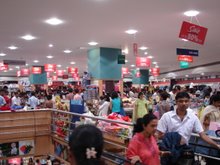Not Connecting To Indian Consumers,Local Websites Of Multinationals Way Behind Western Counterparts In Terms Of Content, Look
FORGET Web 2.0. When it comes to online user interface for their Indian consumers, MNCs still have a long way to go. For most leading global brands, local Indian websites are nothing compared to their websites for developed markets. Userfriendliness, interactivity and content — on all counts, Indian websites have a long way to go before catching up with their global counterparts. Want to find your nearest Motorola dealer? Click on ‘local dealers’ on Motorola India’s website and you come to: ‘Motorola’s products are distributed through the main channels and shops for (mobile) communication. We advise you to contact your local communications specialist with regards to availability and prices of Motorola products’. Huh? Motorola’s US website, on the other hand, offers a dropdown menu for a user to find the nearest dealer. LG Electronics is another example. The consumer electronics major has two websites- lgindia.com — which appears first if you google ‘LG India’ — and lgezbuy. A user visiting lgindia to find the nearest LG dealer would not find the option. Well, go to products, select a product and then you’ll find the option to locate an LG dealer- click and you’re taken to the lgezbuy dealer locator page. Phew! It is, however, much easier finding LG service centres and the online shopping option on the website. The difference also extends to the ‘look & feel’ factor . A case in point is the website of FMCG major Unilever and that of its Indian subsidiary, Hindustan Unilever. While Unilever’s site is colourful, vibrant and consumer-oriented, HLL’s website leans more towards a corporate user. So, if the Unilever homepage has tips on staying fit, healthy and beautiful, quarterly results and other corporate information share prominence with information on HLL brands on the Indian site. Similarly, the global website of Procter & Gamble (P&G) offers tips on issues ranging from nutrition to stress-busting and from beauty to baby care, the Indian website goes just beyond the basic brand information to offer ‘consumer care’ tips like how to differentiate between a cold and a flu and some tips to deal with cough, cold and flu.
While McDonald’s India does better in terms of userfriendliness than most websites, a comparison with the company’s US website shows the increased focus on projecting itself as a responsible brand. So, while the Indian website has a restaurant locator, nutrition info and some fitness tips, the American site offers suggestions on topics ranging from ‘nutrition tips while dining at McD’s’ to ‘food allergens’ and ‘sensitivity info’. It also has sections where a doctor and a personal trainer offer advice. Says marketing consultant Harish Bijoor: “The low Internet penetration in India is one reason why Indian websites lag behind their counterparts in developed markets. There is a more business-to-business focused content in case of Indian sites like more information on topline and core products. The language in a developed market site is different- more casual and friendly.” Adds Indian School of Business marketing professor Nirmal Gupta, “The lack of consumer sophistication in India is another factor why brands think they can get away without paying so much attention to their websites and hence, the low levels of interactivity and user-friendliness.” There are some brands which seem to have missed the India link altogether - denim major Levi’s for instance. Not consumer-savvy Go to Levi’s main website and point towards the Asia-Pacific link. While India is listed there, clicking on it would lead one to the Asia Pacific website of Levi’s. Countries listed on the A-Pac website are Australia, Indonesia, Korea, Malaysia, Philippines, Hong Kong, Japan, New Zealand, Singapore, South Africa (Asia Pacific?), Taiwan and Pakistan. No India, however. Want to check out Nike India? Well, you can’t, because the website doesn’t exist. Nike’s global website, which leads one to the other regional websites, doesn’t have India or Asia in its list at all. Singapore is there, and so is Middle East - but that is as close as you can get. Says Mr Bijoor, “As the market develops, the shift of focus from businessto-business to business-to-consumer will take place but that is another 3-5 years to go.”
Courtesy: EconomicTimes


No comments:
Post a Comment